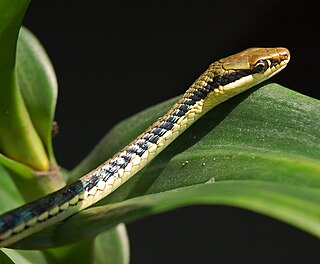
Dendrelaphis pictus is a species of snake found in Southeast Asia and India.

Lytorhynchus paradoxus, commonly known as the Sindh awl-headed snake and the Sind longnose sand snake, is a species of snake in the family Colubridae. The species is native to the desert areas of Pakistan and India (Rajasthan).

Günther's black snake, Bothrolycus ater, is a species of poorly known lamprophiid snake endemic to central Africa. It is the only member of the genus, Bothrolycus. This snake is notable as one of the few snakes with notable sexual dimorphism, as well as possessing a small pit anterior to the eye. While superficially similar to the thermal pits of vipers, its function remains unknown.
Brachyophis is a monotypic genus created for the rear-fanged venomous snake species, Brachyophis revoili, commonly known as Revoil's short snake, which is endemic to Eastern Africa. Three subspecies are recognized as being valid.
Hypoptophis is a monotypic genus created for the rear-fanged (opisthoglyphous) venomous snake species, Hypoptophis wilsonii. The species, which is endemic to Africa, is in the subfamily Aparallactinae of the family Lamprophiidae. There are no subspecies that are recognized as being valid.

Macrelaps is a monotypic genus created for the rear-fanged (opisthoglyphous) venomous snake species, M. microlepidotus, endemic to South Africa. No subspecies are currently recognized.
The Cameroon racer, Poecilopholis cameronensis, is a species of fangless venomous snake endemic to Africa. Poecilopholis is a monotypic genus created for this species.
Aparallactus lineatus, or the lined centipede-eater, is a species of venomous rear-fanged snake in the family Atractaspididae.
Aparallactus niger is a species of venomous rear-fanged snake in the family Atractaspididae. It is endemic to Western Africa.
Polemon acanthias, or Reinhardt's snake-eater, is a species of venomous rear-fanged snake in the family Atractaspididae. It is endemic to Africa.
Polemon barthii, or the Guinea snake-eater, is a species of rear-fanged venomous snake in the family Atractaspididae. The species is endemic to Africa.
Polemon christyi, or the eastern snake-eater, is a species of venomous rear-fanged snake in the subfamily Aparallactinae. The species is endemic to Central and East Africa.
Polemon collaris, or the collared snake-eater, is a species of venomous rear-fanged snake in the family Atractaspididae. It is endemic to Africa.
Polemon gabonensis, or the Gaboon snake-eater, is a species of venomous rear-fanged snake in the family Atractaspididae. It is endemic to Africa.
Polemon neuwiedi, called commonly the Ivory Coast snake-eater or Neuwied's polemon, is a species of venomous rear-fanged snake in the family Lamprophiidae. The species is endemic to West Africa.

Polemon notatus is a species of venomous rear-fanged snake in the family Atractaspididae. It is endemic to Africa.
Xenocalamus bicolor, or the slender quill-snouted snake, is a species of venomous rear-fanged snake in the family Lamprophiidae. The species is endemic to Africa. Six subspecies are recognized as being valid.

Aparallactus lunulatus, or the reticulated centipede-eater, is a species of venomous rear-fanged snake in the family Atractaspididae, which is endemic to Africa.

Aparallactus modestus, or the western forest centipede-eater, is a species of venomous rear-fanged snake in the Atractaspididae family,
Aparallactus nigriceps, or the Mozambique centipede-eater, is a species of venomous rear-fanged snake in the family Atractaspididae.






